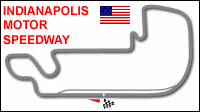|
On the face of it, Indianapolis is the most simple possible circuit, four straights and four corners, all left-handers. In practice, however, it is fraught with subtleties as the track surface changes depending on the time of day, the weather and the amount of rubber on the surface. while this is true of all circuits, nowhere is it more critical than at Indianapolis and Robin Herd once described engineering a car at Indianapolis as, 'trying to solve a moving crossword.'
The Indianapolis International Speedway (there is also a circuit called Indianapolis Raceway Park) opened in 1909 as a 2.5-mile track paved with bricks. Each of the long straights is 3300 feet lone, the short straights are 660 feet. Each turn is 1320 feet long and banked at 9 degrees and 12 minutes. The track is now surfaced with tarmac and there have been subtle changes made to the turns to slow down cars - or to speed them up when the Indy Racing League took over the Indianapolis 500.
'The Brickyard', as it was soon dubbed, held its first 500-mile race in 1911 and the Indianapolis 500 is now the world's oldest continuously-run motor race. It is also the richest motor race and the world's largest single-day sports spectacle.
Actually, while the race itself takes place on a single day, the entire month of May is given over to it. Practice usually starts on the first Saturday in May and the second Saturday is the first qualifying day, weather permitting. The fastest time set on the first qualifying day secures pole position regardless of times set on subsequent days. It is therefore possible for the driver with the fastest time in qualifying to start from 33rd, last, place on the grid.
The Indianapolis 500 was included in the World Championship, 1950-60. It seems a bizarre decision, but in 1950 both Formula One and Indycar had a common denominator in that both allowed cars of 4.5-litres even though that is where the similarity ended. It was the only Championship event where the onset of rain meant automatic postponement or stoppage.
Indianapolis is more than just a track, its presence has attracted many American teams and motor racing suppliers to base themselves in its vicinity.
A lap of the Indy F1 circuit with Mclaren 'tester' Alexander Wurz:
"As you cross the famous yard of bricks at the Indianapolis Motor Speedway, you reach the fastest speed on the circuit, 200 mph (320 kph) in seventh gear as you head down towards Turn 1. Braking dramatically, your speed drops to 75 mph (120 kph) in third gear for the 90-degree right hander, which takes you off the oval and onto the infield section of the track. The circuit immediately flows into a sharper left-hander, which is negotiated at 70 mph (115 kph) still in third gear. Accelerating out of the corner, you sweep through the slight right hand curve, reaching 130 mph (210 kph) in fourth gear that leads you into Turn 4.
This long right hand corner is taken at 80 mph (128 kph), also in fourth gear. On the exit, a short burst on the throttle sees you reach 140 mph (225 kph) on the approach to Turn 5. Dabbing the brakes, this left hander is taken at 105 mph (168 kph) in fourth gear. Another short spurt of acceleration and you reach Turn 6. Braking hard to a speed of 75 mph (120 kph) in third gear, this double left-hander sweeps you round 180-degrees and is immediately followed by the sharp right of turn seven, which is taken at 70 mph (112 kph) in second gear.
Leading on to the back straight, you must take the right line out of the corner to be able to maximise your speed along the straight. Accelerating hard, you reach 185 mph (296 kph) in sixth gear before dropping down the gears to take the 90-degree left-hander at the end of the straight, at 75 mph (120 kph) in third. You then enter the tight S-Bend complex of turns nine and ten. The tight right-hander of nine is taken at 46 mph (75 kph) in first gear, with your speed increasing slightly to 50 mph (80 kph) in second gear for the following left-hander.
Accelerating away along another short straight, you reach 126 mph (200 kph) in third gear before braking to 80 mph (128 kph) for the right hand curve of Turn 11. As you accelerate out of the corner, your line is vital as it leads into Turn 12, the point where you rejoin the oval, and the start of the fastest section of the track.
You must maintain your speed as you take the sweeping right-hander, at 155 mph (248 kph) in fourth gear. You then continue to power up through the gears as you negotiate the long right-hand banking of Turn 13, reaching speeds of 190 mph (305 kph) in seventh gear before the track flattens out for the long start-finish straight. With full-throttle being maintained for up to 20 seconds, the longest full throttle time of any circuit on the calendar, you reach 200 mph (320 kph) in seventh gear as you cross the finish line."
|























